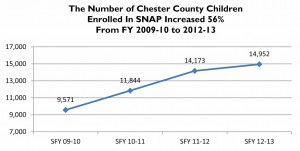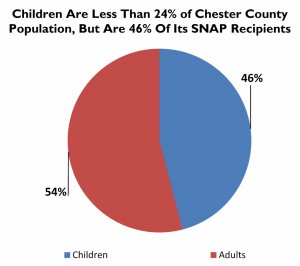Chester County is a nice place to live. Throughout the recession, the median family income never dropped below $100,000. In 2010, the Inquirer reported that Chester County was among the 25 richest counties in the nation. That’s out of more than 3,000 counties. On the whole, the financial situation in Chester County is a good one. But when we look a little deeper we find a troubling trend: while things are fine at the top of the economic spectrum, things are getting worse at the low end—especially for children.
While the median family income in Chester County is within 1% of where it was in 2008, the number of children living in poverty has increased 55% in that period. Of those children living in poverty, nearly half of them are living in deep poverty, below half the poverty line. That’s less than $12,000 a year for a family of four. But why focus on children? Because poverty does not affect everyone equally; in Chester County, the poverty rate for children is nearly 50% higher than that of seniors. Children make up less than a quarter of the county’s population, but almost half of its population receiving food stamps.
One of the problems of living in such an affluent county is that there can be a stigma attached to enrolling in supplemental assistance programs, such as signing up your children for free or reduced-price school meals. With low pre-recession unemployment rates, Chester County is not used to dealing with so many people in need, people at the low-end of the economic spectrum who were hit much harder than the majority of the county. It is imperative that schools and local municipalities do whatever they can to ensure that their students get the nutrition they need, whether this means changing the time, location and method of service of breakfast or reaching out to parents with the benefits of enrollment. It is true that taken as a whole, things look good for Chester County; but it won’t truly be good until that can be said about every child in the county.



